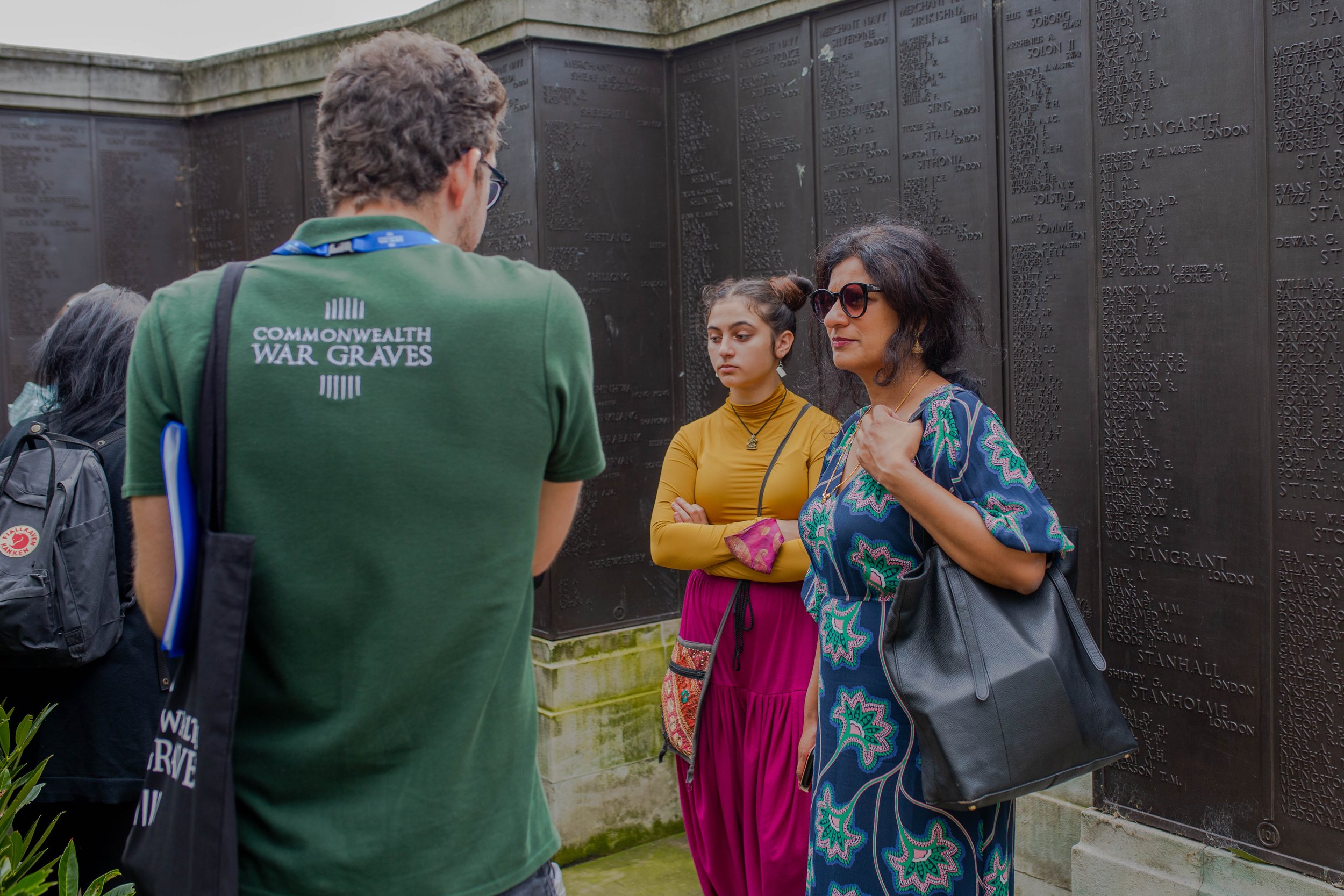Indian Seafarers commemorated at Tower Hill
How many times have we walked by Tower of London, and do we think of the Indian Seafarers commemorated nearby? Have we ever stopped to read the names on the plaques? Wondered who they were? Probably not, as many of the South Asian communities in East London who live nearby were not aware or familiar with this history either. Over the weekend when many in the South Asian communities are reflecting on Indian and Pakistani Independence Day, I collaborated with Commonwealth War Graves Commission for our ‘Indian Seafarers’ event in August at the Tower Hill Memorial to explore the various stories and names we have come across on the plaques and to discover why they were so important.
The Tower Hill Memorial, based in Trinity Square, commemorates the many men and women of the Merchant Navy and Fishing Fleets who died during the World Wars. These men and women have no known grave. Amongst the benches, the panels have thousands of names of the ships and those who died. There was a vast number of names of all different races and religions from Indians, Arabs, Chinese, Norwegian and British. The role of the Indian Seamen was to transport food, munitions, troops, and many essential raw items. The stories of Indian Seafarers are often overlooked as much of the names were never recorded, so Tower Hill Memorial is a place where some of this history can be pieced together. It is estimated that 55,000 of the labour force during Second World War were Indian. There were approximately 1,200 prisoners of war and around 6,500 Indian seafarers who lost their lives. The Indian Lascars as they were often referred to were paid a lot less than the British seafarers.
Together as a group we examined the names and the most common South Asian surnames we saw were Ali, Khan, Uddin and Miah. What became of interest were that on one ship there were 4 Indian seafarers with the same surname of Ali. They were not related at all but could have been from the same town in India. Some of the stories that Commonwealth War Graves Commission and our volunteers explored were
Surgeon K J Bhamgara Pier 1, Course 2 SEANG CHOON
Ship’s doctor on SS Seang Choon, a passenger ship built in 1891 in Belfast. As the Cheshire she was used as a troopship for the South African War of 1889-1902. Sold and renamed Seang Choon in 1910, in 1915 she was again requisitioned as a troopship, this time for the Gallipoli Campaign, and Bhamgara may have been on board for this – he was working on this ship in early 1916 when she docked in Australia. On 10 July 1917 she was enroute from Sydney to London when a German U-boat torpedo sank her off Fastnet. The CWGC commemorates four of the crew, two buried in cemeteries in Ireland/UK and two here on Tower Hill.
Kaikhushru Jehangir Bhamgara was born in Bombay. He qualified in medicine at the University of Glasgow in 1902. He died aged 38, apparently unmarried, his father Jehangir S. Bhamgara then residing in Wadia House, Wadia St., Tardeo, Bombay.
Surgeon Badrinath Balwent JOSHI Panel 88 ROHNA
SS Rohna was a cargo liner large enough to need a crew of around 200, requisitioned as a troop ship in 1940. On 25 November 1943 she was carrying over one thousand American troops, sailing as part of a convoy headed through the Mediterranean to Alexandria. The convoy was attacked off the coast of Algeria by German bombers, some of which were carrying the earliest form of a guided missile – radio guided, rocket boosted glide bombs. One of these struck Rohna and damaged her seriously, including flooding her engine room, setting the ship on fire and destroying six out of 22 lifeboats. Damage and the angle of list interfered with the launching of lifeboats. Over 1,200 men were killed, most of them US personnel, but 117 were merchant seamen.
Most of these seafarers were members of the Indian Merchant Service, so the CWGC commemorates them via the Bombay/Chittagong 1939-1945 War Memorials. Only eight men are named here at Tower Hill, and one of them is Badrinath Balwent Joshi. Born in Bombay, and an Ayurvedic practitioner rather than a physician or surgeon trained in Western medicine. It would seem the British India Steam Navigation Company was happy support the wellbeing of their almost entirely Indian crew by providing a Registered Ayurvedic Practitioner. Blawent is named here, as he was not part of the Indian Merchant Service. His crewmates named here with him include two Chinese seamen and a Purser with Portuguese and Indian connections.
It is easy to walk past war memorials in London as we do not associate them with Indian names. The Tower Hill Memorial is placed centrally and with a tourist attraction close by. So next time you’re in the area or passing by, please pop down and have a look. Research your own family history and you might have a connection to one of the names on the plaques. If you do, let me know how you get on.




